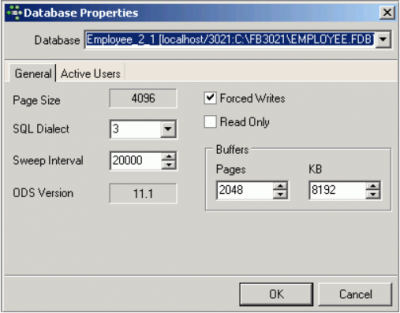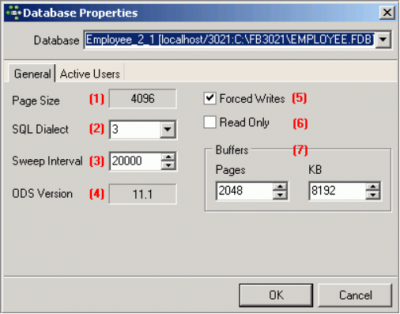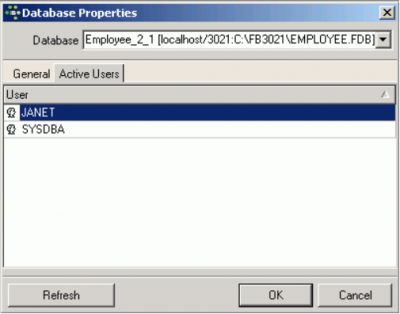meta data for this page
Database Properties
The Database Properties Editor can be started from the IBExpert Services menu. It can be used to specify certain database properties and view other properties appertaining to the database specified in the Database drop-down list (in the upper part of the editor).
There are two tabs labeling the General page and the Active Users page.
General page
The General page displays the following information for the selected database:
(1) Page Size: displays the current specified page size. The page size can only be altered by performing a database backup followed by a restore (IBExpert menu: Services / Backup Database and Services / Restore Database) and redefining the database page size.
(2) SQL Dialect: shows which SQL dialect was specified at the time of database registration. This may be altered here, if wished (although watch out for possible dialect incongruencies, for example, the different DATE and TIME data types).
(3) Sweep Interval: This displays the number of transactions which may be made in the database before an automatic garbage collection is executed by Firebird/InterBase®. If this number is specified at zero (0) it is not performed automatically at all. It could then be carried out, for example, at night as a sweep or backup using GFIX and the at Windows command or the Linux chron command. Please refer to Database sweep for further information.
(4) ODS Version: The ODS (= On-Disk Structure) version shows with which database version the database was created, e.g. InterBase® 5 = ODS version 9, InterBase® 6 = ODS version 10.0, InterBase® 6.5 = ODS version 10.1, InterBase® 7 = ODS version 11. Firebird versions start at ODS version 10.0.
(5) Forced Writes: This enables the forced writing onto disk mode when committing. Please refer to Forced writes for further information.
(6) Read Only: A database can be set to Read Only when, for example, saving the database onto a CD, or in the case of a reference or archive database. The Read Only property is forced in the TIP page, by preventing all insert, alter and delete commands.
(7) Buffers: Here it is possible to specify how much cache the database server should reserve. A good number of buffer pages is 10,000 (based on a 4K page size to allow 40MB cache). The amount of buffers/cache reserved can be viewed in IBExpert here (default = 2,048). If this is increased the database can load considerably more pages. Please refer to Buffers for details.
Active Users page
This page displays those users logged in to the current database with an open attachment. If an application has several attachments, or a single user is connected more than once, this is also visible here. This is important should the database need to be shut down at short notice.
The Active Users page displayed in the SQL Assistant even displays the IP addresses of all active users currently logged on to the database (for those databases with the system table, MON$ATTACHMENTS (Firebird 2.1 upwards)).


